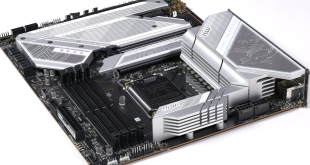Intel Smart Response Technology is included with the Z68 motherboard. This means a user can add a small solid state drive to a system already configured running a larger mechanical disk with the target goal of speeding up the read performance of data which is cached to the SSD. For people who can’t afford a larger SSD but who still need high levels of storage it seems like a handy workaround. This story we wrote last June might be an interesting read.
To take advantage of this you have to enable RAID on the Z68 chipset. When an operating system is installed on a mechanical drive a blank SSD can be used. The chipset drivers are installed and then the new Rapid Storage Technology 10.5 suite. An accelerate tab will be an option if this criteria is met, which then enables acceleration. The system is not limited to Intel drives, but they have to be 64GB or smaller.
Two options are given. Enhanced and Maximised. Enhanced will write data to the mechanical and solid state drive at the same time, limiting the write speed but offering additional power failure data recovery support. Maximised mode moves data from the mechanical drive to the Solid State Drive less frequently but in the case of failure the array needs to be moved to a new system as a pair. Data is stored in a similar manner as a RAID 0 configuration.
The technology really does work and it might suit some people who have a small SSD and don't want to deal with a tiny boot drive.
Lucid Hydra is not one of our favourite technologies. We looked at it recently when we reviewed the new Sapphire P67 Pure Black motherboard back in March and left with mainly negative impressions. Paying extra for this technology was (and is) basically a waste of money. We feel there is a lot of work still to be done before this is a viable platform, as we said on March 17th when analysing the Lucid Hydra platform on the Sapphire Motherboard.
Z68 brings Optimus technology to the desktop market. This allows the user to use both discrete and Intel's onboard GPU without the requirement of making physical system changes to the configuration. There are two modes – ‘D' and ‘I'. D is access via the discrete card and I means Integrated. Three display applications have to be installed to use this. Intel drivers are first, followed by the AMD or Nvidia driver. Finally the Lucid Virtu software is installed which supports GTX 450/Radeon 5700 series and better. Additionally, the technology allows access to the GPU computing technology to assist in tasks such as media encoding when in discrete mode.
While in theory this sounds great, in reality, anyone who has a modern graphics card already has access to this technology via Nvidia CUDA or AMD Stream. Quick tests indicate that as expected , the discrete card outperforms the Intel CPU and Virtu configuration. No shock really.
The software falls flat on its face, yet again, due to the demand on software profiles. None of the leading games we tried worked, such as Dragon Age 2 or Shogun 2. The HD6990 isn't supported and some of the titles that did work, take a very long time to load.
I really have to say it, but this technology really is such a waste of time, resources and effort – just like we said in the Sapphire P67 Pure Black motherboard review, several months ago in March. This particular product was more expensive than similar P67 motherboards available on the market at the time, so it is clear it may add some cost.
 KitGuru KitGuru.net – Tech News | Hardware News | Hardware Reviews | IOS | Mobile | Gaming | Graphics Cards
KitGuru KitGuru.net – Tech News | Hardware News | Hardware Reviews | IOS | Mobile | Gaming | Graphics Cards





